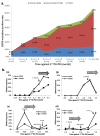Plasma EGFR T790M ctDNA status is associated with clinical outcome in advanced NSCLC patients with acquired EGFR-TKI resistance
- PMID: 26867973
- PMCID: PMC4751431
- DOI: 10.1038/srep20913
Plasma EGFR T790M ctDNA status is associated with clinical outcome in advanced NSCLC patients with acquired EGFR-TKI resistance
Abstract
EGFR T790M mutation occurs in half of non-small cell lung cancer (NSCLC) patients with acquired EGFR-TKI (TKI) resistance, based on tumor re-biopsies using an invasive clinical procedure. Here, we dynamically monitored T790M mutation in circulating tumor DNA (ctDNA) using serial plasma samples from NSCLC patients receiving TKI through Droplet Digital PCR (ddPCR) method and the associations between overall survival (OS) starting from initial TKI treatment and the T790M ctDNA status detected in plasma were analyzed. Among 318 patients, 117 who acquired TKI resistance were eligible for the analysis. T790M ctDNA was detected in the plasma of 55/117 (47%) patients. Almost half of the T790M ctDNA positive patients were identified at a median time of 2.2 months prior to clinically progressive disease (PD). Furthermore, within the patients receiving TKI treatment at 2(nd) line or later, the T790M ctDNA positive group had significantly shorter OS than the negative group (median OS: 26.9 months versus NA, P = 0.0489). Our study demonstrates the feasibility of monitoring EGFR mutation dynamics in serial plasma samples from NSCLC patients receiving TKI therapy. T790M ctDNA can be detected in plasma before and after PD as a poor prognostic factor.
Conflict of interest statement
Yes, there is potential competing financial interests. X.Y., M.Z., Y.S., G.Z. and Y.G. are employees of AstraZeneca during this study. Y.G. holds stock in AstraZeneca. D.Z. reported lecture fees from AstraZeneca, Eli Lilly, Novartis and Pfizer. J.N. reported lecture fees from Eli Lilly, AstraZeneca, Pfizer and F. Hoffman-La Roche. J.X. reported lecture fees from AstraZeneca, F. Hoffamn-La Roche, Eli Lilly and Pfizer. G.C. reported lecture fees from F. Hoffman-La Roche and Pfizer. All other authors declare no conflicts of interest.
Figures




Similar articles
-
A Comparison of ddPCR and ARMS for detecting EGFR T790M status in ctDNA from advanced NSCLC patients with acquired EGFR-TKI resistance.Cancer Med. 2017 Jan;6(1):154-162. doi: 10.1002/cam4.978. Epub 2016 Dec 20. Cancer Med. 2017. PMID: 28000387 Free PMC article.
-
Quantification and dynamic monitoring of EGFR T790M in plasma cell-free DNA by digital PCR for prognosis of EGFR-TKI treatment in advanced NSCLC.PLoS One. 2014 Nov 18;9(11):e110780. doi: 10.1371/journal.pone.0110780. eCollection 2014. PLoS One. 2014. PMID: 25405807 Free PMC article.
-
Digital PCR analysis of plasma cell-free DNA for non-invasive detection of drug resistance mechanisms in EGFR mutant NSCLC: Correlation with paired tumor samples.Oncotarget. 2015 Oct 13;6(31):30850-8. doi: 10.18632/oncotarget.5068. Oncotarget. 2015. PMID: 26334838 Free PMC article.
-
EGFR T790M ctDNA testing platforms and their role as companion diagnostics: Correlation with clinical outcomes to EGFR-TKIs.Cancer Lett. 2017 Sep 10;403:186-194. doi: 10.1016/j.canlet.2017.06.008. Epub 2017 Jun 19. Cancer Lett. 2017. PMID: 28642172 Review.
-
Next-generation epidermal growth factor receptor tyrosine kinase inhibitors in epidermal growth factor receptor -mutant non-small cell lung cancer.Lung Cancer. 2016 Mar;93:59-68. doi: 10.1016/j.lungcan.2016.01.003. Epub 2016 Jan 8. Lung Cancer. 2016. PMID: 26898616 Review.
Cited by
-
Circulating tumour DNA (ctDNA) as a biomarker in metachronous melanoma and colorectal cancer- a case report.BMC Cancer. 2019 Nov 14;19(1):1109. doi: 10.1186/s12885-019-6336-3. BMC Cancer. 2019. PMID: 31727009 Free PMC article.
-
Combined exosomal RNA and circulating tumor DNA for epidermal growth factor mutation detection in non-small cell lung cancer.J Thorac Dis. 2018 Nov;10(Suppl 33):S4023-S4027. doi: 10.21037/jtd.2018.10.17. J Thorac Dis. 2018. PMID: 30631545 Free PMC article. No abstract available.
-
A Multicenter Study to Assess EGFR Mutational Status in Plasma: Focus on an Optimized Workflow for Liquid Biopsy in a Clinical Setting.Cancers (Basel). 2018 Aug 27;10(9):290. doi: 10.3390/cancers10090290. Cancers (Basel). 2018. PMID: 30150518 Free PMC article.
-
Sequencing of circulating tumor DNA for dynamic monitoring of gene mutations in advanced non-small cell lung cancer.Oncol Lett. 2018 Mar;15(3):3726-3734. doi: 10.3892/ol.2018.7808. Epub 2018 Jan 16. Oncol Lett. 2018. PMID: 29556275 Free PMC article.
-
The Validity and Predictive Value of Blood-Based Biomarkers in Prediction of Response in the Treatment of Metastatic Non-Small Cell Lung Cancer: A Systematic Review.Cancers (Basel). 2020 Apr 30;12(5):1120. doi: 10.3390/cancers12051120. Cancers (Basel). 2020. PMID: 32365836 Free PMC article. Review.
References
-
- Mok T. S. et al. Gefitinib or carboplatin–paclitaxel in pulmonary adenocarcinoma. N Engl J Med 361, 947–957 (2009). - PubMed
-
- Maemondo M. et al. Gefitinib or chemotherapy for non–small- cell lung cancer with mutated EGFR. N Engl J Med 362, 2380–2388 (2010). - PubMed
-
- Mitsudomi T. et al. Gefitinib versus cisplatin plus docetaxel in patients with non-small-cell lung cancer harbouring mutations ofthe epidermal growth factor receptor (WJTOG3405):an open label, randomised phase 3 trial. Lancet Oncol 11, 121–128 (2010) . - PubMed
-
- Rosell R. et al. Erlotinib versus standard chemotherapy as first-line treatment for European patients with advanced EGFR mutation-positive non-small-cell lung cancer (EURTAC): a multicentre, open-label, randomised phase 3 trial. Lancet Oncol 13, 239–246 (2012). - PubMed
-
- Zhou C. et al. Erlotinib versus chemotherapy as first-line treatment for patients with advanced. Lancet Oncol 12, 735–742 (2011). - PubMed
Publication types
MeSH terms
Substances
LinkOut - more resources
Full Text Sources
Other Literature Sources
Medical
Research Materials
Miscellaneous

